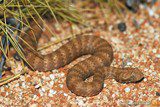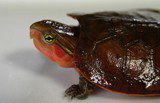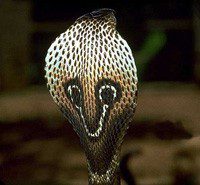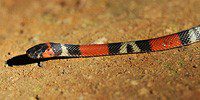
Asp cobra
Cobra snake (Micrurus frontalis) is one of the most spectacular snakes of the Aspid family. Despite its small size (up to 60-70 cm in length), its color immediately attracts attention: red rings alternate with black ones, and each black ring is crossed by two more, pale yellow ones. Unfortunately, the cobra snake is venomous and its venom is fatal to humans. This is the most dangerous neurotoxin, so keeping snakes of this species in a home terrarium is highly undesirable – the death of household members or neighbors from a snakebite falls under article 109 of the Criminal Code of the Russian Federation “Causing death by negligence”, which is punishable by restriction of liberty for up to two years or imprisonment for the same term.
Contents
Classification
Kingdom: Animalia (animals)
Type: Chordata
Class: Reptilia (reptiles)
Order: Squamata (scaly)
Suborder: Serpentes (snakes)
Family: Elipidae (aspididae)
Genus: Micrurus (coral snake)
Species: Micrurus frontalis (cobra snake)
Other names
 The cobra asp in Russian sources is also sometimes called the southern or short-tailed, and often collectively called it the generic name “coral asp”, without specifying the species.
The cobra asp in Russian sources is also sometimes called the southern or short-tailed, and often collectively called it the generic name “coral asp”, without specifying the species.
In English sources, you can find such names as Southern coral snake, Brazilian coral snake, Short-tailed coral snake.
Inhabitation
The cobra snake, like all coral snakes, is distributed in South and Central America, mainly in the southwest of Brazil, Paraguay, Uruguay and northern Argentina. This species prefers to live in temperate and tropical forests, fields and meadows. It is rarely seen in open places, although sometimes it appears even near dwellings. In swamps, the asp does not live and prefers sandy soil or cool, damp forest soil, where plants, earthen mounds, and fallen rotting leaves provide it with shelter. Because The cobra snake is a burrowing snake and spends most of its time in its hiding places on the ground, appearing on the surface only when it rains or during the breeding season. Therefore, it is easy not to notice it and stumble upon it by accident, and it is extremely difficult to catch it on purpose.
Description
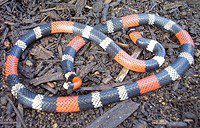 It has an unusual bright, contrasting pattern. It consists of alternating wide red and black rings, with the black rings broken up by narrow pale yellow ones. In nature, there are even some non-venomous species of snakes that mimic the color of coral asps, such as the milk snake (Lampropeltis triangulum).
It has an unusual bright, contrasting pattern. It consists of alternating wide red and black rings, with the black rings broken up by narrow pale yellow ones. In nature, there are even some non-venomous species of snakes that mimic the color of coral asps, such as the milk snake (Lampropeltis triangulum).
In length, the cobra asp rarely exceeds 70 cm. A slender body with small eyes and smooth scales ends in a short tail. The head is small and blunt, the mouth is relatively small and weakly extensible. The dentition is highly specialized: the maxillary bone is very short, and the upper jaw has only paired poisonous teeth. However, they are quite primitive – they are located motionless in the oral cavity and are not retracted after an attack, as, for example, in a viper. Unlike the same viper, cobra asps do not release the victim immediately after the attack, but hold on tightly with their teeth during the bite to speed up the action of the poison.
Despite the high specialization of the dental apparatus of this species, its bite is extremely dangerous for humans. Without timely assistance, a lethal outcome is guaranteed and occurs in less than a day. The venom of the cobra asp is neurotoxic and causes depression of the respiratory center and nervous system. Although the bite of this snake is fatal, this species is not prone to aggression and attacks on humans. In the US, the cobra asp accounts for only 1% of snake bites, and these are usually accidental – for example, during farming.
Content
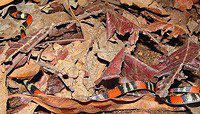 As mentioned above, all asps are extremely poisonous. And the content of poisonous snakes is always associated with great difficulties and is unacceptable in a home terrarium, because. too risky for the owner and for those around him. If you still decide to take such a step, remember the rules.
As mentioned above, all asps are extremely poisonous. And the content of poisonous snakes is always associated with great difficulties and is unacceptable in a home terrarium, because. too risky for the owner and for those around him. If you still decide to take such a step, remember the rules.
Keeping deadly poisonous asps in a normal environment is dangerous not only for your life, but also for the lives of others. Therefore, it is highly desirable that a separate specially equipped room be allocated for the maintenance of poisonous snakes. Ideally, this is an empty bright room with carefully plastered cracks, including ventilation holes, and terrariums, standing close to the wall.
The light must always be on, because snakes see in the dark much better than people. Inside the room, in addition to the terrariums, you need to keep only serum and tools, as well as a telephone with a list of emergency numbers. The room itself must be locked, just like terrariums.
Asps should be placed in a strong (if plywood, then thicker than 3 mm), securely closed terrarium without gaps. Newborns are very nimble, and adult asps can bite or spit poison through the hole found.
To handle poisonous snakes, special devices are needed – hooks of various sizes, clamps or tongs to limit the mobility of the snake, plexiglass shields, buckets and spoons for feeding. But, of course, the most important tool is the serum. When processing cobra asp, never take it with bare hands. Inexperienced people should not approach a poisonous snake, or admire it in a tightly closed terrarium.
Food
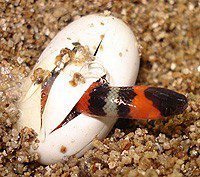 In nature, the main diet of the cobra snake, like all snakes, is reptiles. However, they may also consume large insects and various amphibians, as well as small mammals, sometimes even birds.
In nature, the main diet of the cobra snake, like all snakes, is reptiles. However, they may also consume large insects and various amphibians, as well as small mammals, sometimes even birds.
Feeding asps in captivity has its own characteristics. When choosing feeds, one should strive to ensure that they correspond as closely as possible to the natural food of snakes. Because all asps are predators, the owners usually breed or buy food animals – small mice, crickets, earthworms, Madagascar cockroaches, etc.
The cobra snake in nature leads a burrowing lifestyle, so it is necessary to arrange artificial burrows in the terrarium. This will help to transfer the snake to more affordable food: mice are placed in underground passages, simulating hunting, and later the snakes themselves learn to take them directly from the feeder. Transfer to another food should be done gradually, carefully monitoring the health of the pet. After feeding, snakes should not be disturbed, hypothermia is also dangerous – the speed and quality of digestion of food in them depends on the ambient temperature (when the temperature drops from 28 ° C to 18 ° C, the rate decreases by about 3 times). Any stress can cause regurgitation of food, which is fraught with inflammation of the digestive tract.
The amount of food depends on the age of the asp, but in no case should overfeeding be allowed. Adult cobra snakes in a terrarium are usually fed once a week, and young ones twice a week.
Snakes can go without food for quite a long time, but they die without water after 3-5 days, so the drinker should always be filled with clean water.
Reproduction
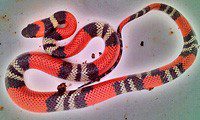 If you have several animals, the natural thought is to breed snakes and have numerous offspring. But there is one caveat – it is very difficult to breed poisonous snakes in captivity, and even experienced herpetologists do not risk doing this without special conditions. In addition, asps breed extremely poorly in captivity.
If you have several animals, the natural thought is to breed snakes and have numerous offspring. But there is one caveat – it is very difficult to breed poisonous snakes in captivity, and even experienced herpetologists do not risk doing this without special conditions. In addition, asps breed extremely poorly in captivity.
In nature, the cobra asp brings offspring once a year (on average, 10-12 cubs per offspring) and belongs to the egg-laying species of snakes. Cobra snakes live in tropical conditions and can breed all year round, regardless of the season. The female builds a nest in a pile of fallen leaves and warms the eggs with her warmth, protecting them from temperature changes and the encroachment of others.
Transportation
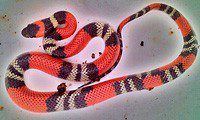 In addition to maintenance, nutrition and reproduction, one should not forget about such an important point as transportation. Transportation of aggressive venomous snakes is dangerous not only for the owner, but also for others, so it is important to follow the rules.
In addition to maintenance, nutrition and reproduction, one should not forget about such an important point as transportation. Transportation of aggressive venomous snakes is dangerous not only for the owner, but also for others, so it is important to follow the rules.
The main mistakes of the owners are unsuitable containers for transportation and improper transportation.
The best option would be to place the asp in a suitably sized bag made of thick fabric. In addition to the snake, you can even put a few pillows in the bag. The main requirement is the absolute absence of holes and a well-tied knot. Asp should be placed there slowly and carefully so as not to provoke an attack of aggression. It is better to carry a snake in a bag, holding it by the upper part, and keep it away from your body.
However, one bag is not enough when transporting a poisonous snake. A box (cardboard or wooden) is also needed. A cardboard box is good because it protects the snake from temperature changes, but its minus is poor shock resistance. From the point of view of strength, a wooden box is ideal, but, on the contrary, there is no temperature control in it. Therefore, it is better to put the snake in a bag and two boxes – first in cardboard, then wooden.
When packing several snakes, place cardboard partitions between the bags to prevent injury or death from mutual bites.
Another caveat – always transport poisonous snakes by private transport. City transport is not intended for their transportation at all, the consequences of escaping will be terrible. Inside the car, the box must be placed so that it does not break during a sharp turn or braking. And, just in case, always have a few hooks and grapples with you.
Additionally
Transportation is so important because the coral snake is the 4th most venomous snake in the world. Its poison is the most dangerous neurotoxin. Usually, a bitten person does not feel pain at the site of the bite, however, shortly after the bite, weakness develops in the limbs – paralysis begins. Spreading, paralysis gradually captures all organs, makes it difficult to breathe, speech, eyelids fall, lips and tongue are paralyzed, heart failure begins, the face turns blue. During the day, a fatal outcome occurs – primarily due to paralysis of the respiratory center and skeletal muscles, leading to a weakening of breathing up to a complete stop.
Sources of
http://www.biodat.ru
http://dic.academic.ru
http://ru.enc.tfode.com
http://ours-nature.ru
http://slovarik.net
http://www.theterrarium.ru/
http://reptiliy.net/
http://big-snake.narod.ru/



